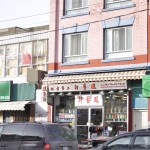Breaking
Author Leslie Shimotakahara's novels offer literary passageways to places in the past
Striking a balance: Artist Kaylie Hatashita balances performance art and personal healing
Never Been Better: Author Leanne Toshiko Simpson uses romantic comedy explore mental illness
Treasures from the Nikkei National Museum: Tashme Women with Newborn Robert Banno
An ice-breaking season: Akane Shiga joins team Ottawa in new hockey league
Mindfulness in the city: Kimchi for the body and soul
Osaka troupe Karakoro brings author Joy Kogawa's book to life
Is your family from Ucluelet on the West Coast of Vancouver Island?
Treasures from the Nikkei National Museum: Portrait of Cana, Mata, and Myea Okamura
Nikkei Voice’s Cafe and Restaurant Compendium
Welcome to Nikkei Voice’s Japanese Cafe and Restaurant Compendium. This small list is a look into some of the many restaurants Nikkei Voice writers and reviewers have gone to throughout Canada.
Below you will find a number of stores each with small excerpts from the reviews written about each establishment. Remember, tastes differ! However, we believe our reporters have pretty good taste.
Nikkei Voice Eats
Ramen & Izakaya Ryoji (Interview)
TORONTO — Ramen & Izakaya Ryoji is the first Okinawan-style Japanese restaurant in Toronto. On a cold January day this year, the owners opened its doors and Torontonians found a warm and welcoming atmosphere inside.
Okinawa, as you may know, is a group of islands located in the south part of Japan. Ryoji, which is a chain of restaurants, in Toronto is new, but the ‘Ryoji Family’ legacy has a long, old history.
By opening this Ryoji restaurant in Toronto, the Ryoji Family’s long cherished dream of opening a restaurant overseas has finally come true! Mr. Kota Uechi, the owner, tries to bring customers a taste of a different culture, separate from the mainland of Japan. By serving people traditional and creative Okinawa cuisine and ramen rooted he introduces them to Okinawa’s rich history.
-Ramen & Izakaya Ryoji-
Website: http://www.ryojiofcanada.com/
Address: 690 College Street, Toronto, ON
Phone: 416-533-8083
Hours: Sunday – Thursday: 12 p.m. – 12 a.m. | Friday – Saturday: 12 p.m. – 2 a.m.
Email: N/A
Teppan Kenta
TORONTO — “Teppan Kenta” is a Japanese Teppanyaki restaurant in Toronto that opened on September 5th, 2013, and the restaurant’s popularity is skyrocketing with Torontonians.
For those who don’t know, Teppanyaki is a style of Japanese cooking that involves using a iron skillet to cook everything from steak, shrimp, okonomiyaki, and yakisoba. It’s a fiery and lively style of cooking.
Kenta Taniguchi is the owner of Teppan Kenta. Kenta studied at a vocational college of cookery in Japan and after he graduated from the college, and worked as a chef in a hotel who specialized making Chinese food. Kenta learned about the Teppanyaki business through working at an Izakaya restaurant in Japan, and has been enthralled by it ever since.
Kenta suggested us Hiroshima-style Okonomiyaki (Japanese pancake) the best. That was quite filling and juicy, and tastes exactly like I feel I came back to Japan. If you hear Teppanyaki style steak house, it sounds very expensive and not really easy place to go for dinner. But Teppan Kenta is offering reasonable prices and casual atmosphere for making customers feel comfortable to come in.
-Teppan Kenta-
Website: teppankenta.com
Hours: Monday-Friday 9:00am-12:00pm
Address: 24 Wellesley Street w Toronto
Phone: 647-345-0905
Email: info@teppankenta.com
Koiya Izakaya
TORONTO — On St. Clair Avenue West, there’s a Japanese restaurant with a vivid orange sign. In bright letters it says, “Koiya Izakaya”.The restaurant has an airy patio and amusing interior decorations. Inside there’s a big clock with a red carp and there are also suspended colourful carp streamers called Koinobori hanging from a ceiling.
The beef tongue is braised for two hours. Although the taste is light, it soaks into the meat making it juice and tasty. It is served thickly cut and also has chopped green onion and sesame on top. When I bit into it, I could taste the broth and a slight hint of Miso. It tastes very good.
A personal recommendation is the “Cheese Cake Tempura”. Cheesecake is deep-fried with a light tempura batter. Condensed milk is put on it, as well. It is served with red raspberry, whipped cream, and three kinds of ice creams, taro, black sesame, and green tea flavor.
-Koiya Izakaya-
Website: koiyaizakaya.com
Hours: Monday-Thursday 12pm-11pm | Friday 12pm-12am | Saturday 4pm – 12am
Address: 813 St. Clair Ave. W, Toronto, ON, M6C 1B9
Phone: (416) 651-4217
Email: koiya.izakaya@koiyaizakaya.com
J-Town
TORONTO — Ever since I went to Japan, curry had been on my mind. In an average Japanese city, you can find a place to buy a bowl of steaming-hot curry on almost any street, and it’s usually spicy to boot. Train stations have special compact restaurants where you put some coins into a machine, it gives you a receipt, you hand it to the chef behind a counter, and you sit – with 20 other business people around you – eating your curry before it gets cold.
Curry is almost like the mashed potatoes and gravy that we are used to here in Canada, but unlike it, finding a genuine bowl of Japanese-style curry in Toronto is a difficult task. Most of the time, you have to resort to buying curry in blocks that you melt alongside vegetables that are almost cooked just the right way. It’s a process that ends in curry, but it’s never quite the same as what you can get as you wait for the Shinkansen.
A plate of curry is placed before me. The sauce is golden brown and it has just the right size bits of carrots and potatoes to make it mouth-wateringly delicious. To top it off, a large Katsu has been put on top and with a generous helping of Tonkatsu sauce the dish is complete. It’s the curry that brings me back to J-Town over and over, but the location has humble beginnings
-J-Town-
Website: www.jtown.ca
Hours: Tuesday-Friday 10:00am-7:00pm
Address: 3160 Steeles Ave E, Markham, ON L3R 4G9
Phone: (905) 305-1720
Email: info@jtown.ca
Aotoya Blue Door
VANCOUVER — A friend and I dined at Aotoya on a recent Friday night, delighted that it is matsutake (pine mushroom) season. The tri-fold menu has many photos to help diners select, supplemented with numerous handwritten signs on the walls and counter in English and Japanese featuring current specials. Our charming server, Emiko, helped with ordering, and explanations throughout the meal.Aotoya means “blue door”, and indeed, there is a blue door on the restaurant. If you’re looking for it on the street, the blue awning carries Japanese characters, and also, “Blue Door” in English. Located in a modest neighbourhood on south Victoria Drive in Vancouver, Aotoya offers good value, for a casual meal of authentic Japanese home-cooking.
-Aotoya / Blue Door-
Website: http://tenhachi.net/
Hours: Lunch: Tue-Sun 11a.m. – 2 p.m. | Dinner: Tue-Sun 5 p.m. – 9 p.m.
Address: 6543 Vicotoria Drive. Vancouver BC V5P 3X9
Phone: 604- 327-1158
Email: N/A
Kingyo Izakaya
TORONTO — With episodes of the 70s Japanese hit, Kamen Rider projected silently above the busy sushi bar and a handful of flashing pachinko machines lining the century brick walls, Kingyo is a welcome addition to the quickly gentrifying, old Cabbagetown neighbourhood.
Upon entering, you’re greeted with the typical staff calling out of “irrashaimase!” The staff are friendly, attentive, and are very open to giving both drink and food recommendations for the first time diner. As with any izakaya experience, bring friends and family. The more people at the table, the better chance you have to try out multiple dishes. And you want to try a lot of them.
• For a decadent and sinfully buttery starter, definitely try the Uni Shooter ($7.80). A beautiful combination of shiso, sticky yamaimo, sushi rice, sea kelp, yuzu orange, and sea urchin, this appetizer can be enjoyed slowly with a small wooden accompanying spoon, or taken as a shot of delectableness.
• With only 10 servings made per day, the Kyoto Style Shojin Assortment ($15)is a vegan, chef’s choice of Buddhist monk recipes – a wonderful assortment of nine small dishes (kobachi) are rotated daily, and served in an endearing stacking box, or jubako. Standouts of the serving that day included the lightly battered and fried sweet corn, and the enoki mushrooms wrapped in baby bok choy.
• As for dessert, I would recommend the 2 Colour Almond Tofu ($5.80), served with a fresh berry and jasmine sauce. The perfect sweet end to any meal. Although I want to be selfish and keep Kingyo all to myself, it’s no secret that izakayas have taken over Toronto, and that is a glorious thing to be able to say out loud – finally.
-Kingyo Izakaya-
Website: http://www.kingyotoronto.ca
Hours: Mon-Sun 5:30 pm – 11:30 pm
Address: 51B Winchester Street, Toronto, ON M4X 1R7
Phone: 647-748-2121
Email: See website
Gushi
TORONTO – At Dundas Street West and Bathurst, there is a savory scent in the air.
Following the smell, you will find Gushi, a food stall that sells kushikatsu, one of the popular street foods in Japan. The stall, which looks like a flipped shipping container, serves food made with a combination of pork, quail egg, onion, and okra that are deep fried. Gushi’s original secret sauce makes for a mouth watering experience, and when you take just a bite of the kushikatsu, you can’t help but smile.
Gushi now serves Karaage Chicken with tomato sauce, cheese and basil $7.00 as a taste collaboration of Japanese-style Karaage and Western-style sauces. Gushi also serve a new seventeen-piece Karaage box $25.00, which is good steal for Christmas.
-Gushi-
Website: http://www.gushiisgushi.com/
Hours: Every day 11:30 a.m. – 6:00 p.m.
Address: Gushi Japanese Street Food 707 Dundas Street West
Phone: 416-525-7351
Email: N/A
JAPADOG

JAPADOG’s recommendation, KUROBUTA TERIMAYO that has its original sausage made of a rare breed of pigs called Berkshire with Teriyaki sauce, onion and chopped nori. Photo courtesy: Mizuki Ogi
VANCOUVER — If you’re looking for a unique combination of Japanese and North American food then this is the place to go.
Vancouver-born JAPADOG, who makes Japanese style hot dogs, has been gaining its popularity rapidly. It currently has two stores in Vancouver and New York and several stands and trailers in the Westside of Canada.
So, what’s the big deal? To be honest, I’m not a big fan of hot dogs, however, I was impressed by the variety of hot dogs when I stepped into the store.
There are more than 10 choices; NEGI MISO, YAKINIKU RICE, OKONOMIYAKI, CROQUETTE, TERIMAYO, OROSHI, TONKATSU, UME, YAKISOBA, EBI TEMPURA etc… the restaurant also has a combo menu that includes pop and Shaked (flavoured) fries, which also has various tastes such as butter and shoyu, shichimi and garlic, aonori, and ume shiso. The best part is that each location has a slightly different menu. You never be in love with just one style.
-JAPADOG-
Website: http://www.japadog.com/
Address: 530 Robson St, Vancouver, British Columbia V6B 2B7
Phone: (604) 569-1158
Hours: Tuesday-Sunday | 11:00 am – 10:00 pm
Email: info@japadog.com
Manpuku
Toronto — If you love Japanese food, there’s a great place in downtown Toronto we can recommend.Located inside The Village by the Grange on McCaul Street, Manpuku serves delicious home-style Japanese food. The owner Sakiko Ichihara, who is just 29 years old, says the number of regular customers has increased steadily over its five years of business because of their great food and prices.
To our surprise, the majority of customers are non-Japanese and made up of students, which makes Manpuku a local favourite. When we asked Ichihara why she opened the restaurant she said, “I thought that an Udon restaurant should be open in Toronto,” mostly because Ichihara doesn’t like sushi and sashimi.
I feel nostalgic for any home-cooked Japanese food as its difficult to find real Japanese food in Toronto. I believe I will be regular a customer of Manpuku and I recommend Manpuku to whoever fondly remembers or just likes Japanese food. You may consider which restaurant you should go, but you will relish the Japanese food at Manpuku.
-Manpuku Modern Japanese Eatery-
Website: http://www.Manpuku.ca/
Address: 105 McCaul St. Unit 29-31 Toronto, Ontario M5T 2X4
Phone: (416) 979-6763
Hours: MON-WED 11:30am-8pm | THU-FRI 11:30am-11pm | SAT 12pm -11pm | SUN by appointment
Email: info@manpuku.ca
Ryu’s Noodle Bar
TORONTO — Hovering at around 20 establishments, the row of restaurants and cafes on Baldwin Street is a very competitive landscape. Ryu’s Noodle Bar is a new entrant in the quickly exploding ramen market in Toronto and opened its doors in July 2013 just a hundred feet away from one of its well-known competitors, Kinton Ramen.
This bold choice in location commands the need for Ryu’s Noodle Bar to be compared and contrasted in almost every way with its rival. But I won’t do that today, as there are plenty of other reviews that go into that very analysis online.
Now let’s talk Ryu.
• Those in love with Japanese chashu can rejoice in the 2-Kinds Cha Shu Plate ($6.25), that allows us to have chashu in two ways: lightly grilled with the right amount of fattiness, char, and smokiness, and delicately poached for ultimate smoothness. Comes with a spicy yuzu-based sauce, and XO sauce for dipping.
• The very simple Shio Ramen ($9.50), was provided with an abundance of perfectly cooked noodles, but an overload of bean sprouts, and was quite average, until the addition of the House Special XO Sauce mid-meal. This ratcheted up the flavour to a lovely level of seafood goodness.
• Based on a broth of both shiro and aka (white and red) miso, the Miso Ramen ($9.75) was surprisingly light in miso flavour until the addition of the Seasoned House Spicy Oil, which seemed to bring out the tanginess of the miso and blended extremely well with the spiced oil.
• Being a summer seasonal menu item, the Tsukemen ($11.25) is a wondrous cold noodle dish (no broth) that literally means dipping noodles. A great choice for any hot day, the Tsukemen is a very simple dish that is accompanied with a delicious sauce typically made from shoyu, rice vinegar, stock, and mirin.
-Ryu’s Noodle Bar-
Website: www.ryusnoodlebar.com/
Address: 33 Baldwin Street Toronto, ON M5T 1L3
Phone: (647) 344-9306
Hours: Tue-Sat 11 am – 11 pm, Sun 11 am – 10 pm
Email: info@manpuku.ca
Touhenboku
TORONTO — Touhenboku Ramen is about a five minute walk from Osgoode station in Toronto, and it’s creating quite a stir.
“In North America, it’s Tonkotsu. However some avoid eating ramen in pork broth due to their religion or cultural differences. Many people like eating this ramen because it’s made with chicken broth. I want people to know the true taste of Japanese ramen and know that such a delicious ramen is able to be made from chicken,” Zuimei Okuyma, the owner, said having full confidence in his chicken pai-tan ramen.
Ma-Yu Pai-tan Ramen (Black Ramen), Zuimei’s recommendation, has savory garlic flavor with home-made Ma-Yu which is sesame flavoured oil. When Ma-yu is added to Ramen, the taste will be deep, rich, with a pleasant aftertaste.










![[Photo Courtesy: Kaori Fujishima]](http://162.243.236.73/wp-content/uploads/2013/11/koiya_izakaya_09.jpg)

![BLUE DOOR [Photo Courtesy: Cassandra Kobayashi]](http://162.243.236.73/wp-content/uploads/2013/10/dscf5949.jpg)


![Takoyaki $4.99 [Photo Courtesy: Kaori Fujishima]](http://162.243.236.73/wp-content/uploads/2013/09/img_7018.jpg)

![MA-YU PAI-TAN RAMEN (BLACK RAMEN): $10.5 [Photo courtesy: Kaori Fujishima]](http://162.243.236.73/wp-content/uploads/2014/01/tohenboku_ramen_nikkei_voice_toronto_012.jpg)


